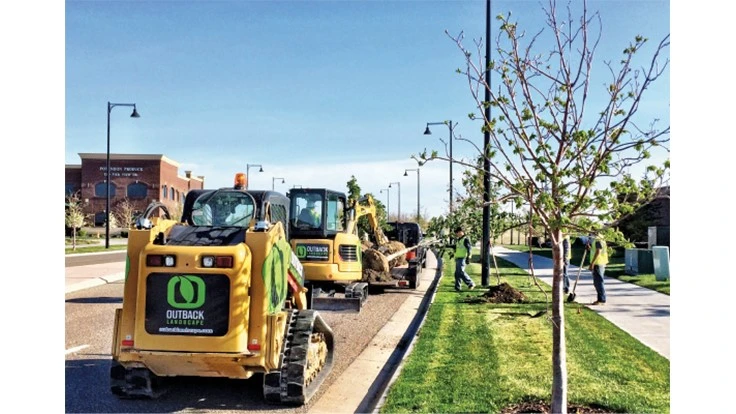
Call them labor savers (or back savers): Tractor loaders manage heavy loads, take care of dirty work like trenching and grading, and they can be the stars of a snow removal fleet.
There are big-job machines that can lift about 9,000 pounds and dig with about 15,000 pounds of force.
Then, you’ve got a compact wheel loader and mini-excavator, which are smaller cousins of the backhoe. Not to mention the skid-steer and compact track loaders with track tires that tread more lightly on properties, says Tyler Washburn, operations manager of Outback Landscape in Idaho Falls.
Outback Landscape has three compact track loaders (track tires) and three “mini loaders,” as Washburn calls them, referring to compact wheel loaders that climb curbs more easily.
“We can also haul more material with those so we use them on bigger job sites,” he says.
And, these wheel loaders have better traction and push-power than track loaders (skid-steers) in snowy environments, Washburn adds.
“Our insurance on those per year is actually less than a truck,” he says of the loader and its cost-effectiveness for snow removal.
Clayton Bassett, purchasing and shop director at Yellowstone Landscape, says, “You can get almost anything done with a mini-excavators, skid-steers and compact loaders.”

Smooth operators.
Training crews to operate loaders safely is a little fun-and-games at Outback Landscape – but don’t let its obstacle course setup fool you.
The idea is to give crews structured, supervised practice during a field day so they can master skills and gain confidence with equipment before using machines on clients’ properties. Safety is paramount.
“We have in-yard training, and in the spring at our employee fair we set up various obstacle courses and cross-train our people to use the different machines,” Washburn says. “We make sure that employees who do not use the loader as much get some experience on the compact track loaders – and the same goes for our mini-excavators and skid-steers.”
Today’s engineering makes machines even easier and safer to operate, Washburn says.
“Controls are easier to manipulate and the cab unit is more comfortable so they can operate the machines longer without getting filthy dirty,” he says.
Maximizing the benefits.
Before purchasing machines like loaders, Outback Landscape takes inventory of the previous year’s rentals to see if the purchase is justified. Will the machine be put to work?
And, once part of the fleet, Outback maximizes the productivity of its loaders with diligent, ongoing maintenance.
“Make sure you get them in for schedule service – and be sure they are getting greased,” Washburn says. “Do a daily check-over of each machine.”
Considering a loader? Before you buy, vet the vendor.
“Partner with someone who will give you the best sales after service – someone who will get the parts for you, and who will stock the parts that commonly go out on these machines,” Bassett says. “Choosing a good vendor is the most important thing. You want someone who can take care of you after the purchase.”
Get curated news on YOUR industry.
Enter your email to receive our newsletters.
Explore the February 2019 Issue
Check out more from this issue and find your next story to read.
Latest from Lawn & Landscape
- Retargeting Ads – A Secret Weapon for Growing Your Lawn Care Business
- Leading a growing company
- Project EverGreen launches Clean Air Calculator
- Rain Bird acquires smart lawn care company OtO from Toronto
- PBI-Gordon names Marvin as VP of research and development
- Mean Green rolls out Vanquish Autonomous mower
- Focal Pointe launches new podcast series
- Navigating due diligence checklist for selling lawn business






